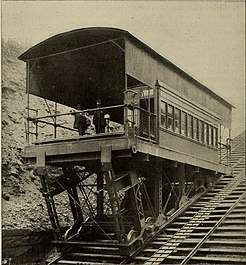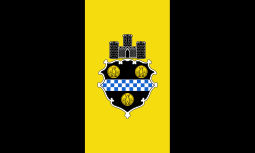Castle Shannon Incline
The Castle Shannon Incline was a funicular railroad in Pittsburgh, Pennsylvania. It was originally part of the Pittsburgh and Castle Shannon Railroad route to the suburb of Castle Shannon. It replaced an earlier incline dating to 1825 that brought coal down from a mine in Mount Washington. Initially opened on 26 August 1890,[2] the incline operated for only a few days before breaking down,[3] the original machinery being unable to bear the strain of the large freight and passenger cars.[4] After a second abortive run in October, it was decided that the machinery had to be replaced.[5][6] The refitted incline opened on 7 March 1891.[7] It ran from Bailey Avenue west of Haberman Avenue down to Carson Street just west of Arlington Avenue.[8]
| Castle Shannon Incline | |
|---|---|
 --Castle Shannon Incline car | |
| Overview | |
| Locale | Mount Washington, Pittsburgh (mountain) |
| Coordinates | 40.4292°N 80.0026°W |
| Operation | |
| Opened | 26 August 1890 |
| Closed | 21 June 1964 |
| Owner | Pittsburgh Railways |
| Technical | |
| Line length | 1,375 feet (419 m)[1] |
| Track gauge | 10 ft (3,048 mm)[1] |
The oldest part of the Pittsburgh and Castle Shannon Railroad was a coal mine in Mount Washington. When the mine was played out in 1861, the company opened the back (south) side of the mine and continued it down a horseshoe curve into the Saw Mill Run valley to other coal mines. The company began passenger service in 1874 to develop towns at Fair Haven (Overbrook) and Castle Shannon. Trains ran up the old incline, through the enlarged coal mine tunnel, down the slope and horseshoe curve, and through the valley. Improvements starting in 1890 replaced the route over Mount Washington with the new incline, which became known as Castle Shannon Incline No. 1 when a second less steep incline was built on the south side as Castle Shannon Incline No. 2 in 1892. From that date, the old incline, the coal tunnel, and the railroad down through the horseshoe curve were used only for coal trains and not passengers.
The incline's large cars were able to carry both passengers and wagons, and later automobiles. In 1909 steam railroad passenger service on the Pittsburgh and Castle Shannon Railroad was replaced by electric cars of the Pittsburgh Railways that ran through the Mount Washington tunnel (still in use today). No longer part of a through route, Incline No. 2 soon became superfluous, but development of a residential area on top of Mount Washington kept Incline No. 1 in business. Originally steam powered, it was converted to electrical operation in 1918 by the Otis Elevator Company.[9] The incline was closed 21 June 1964.[10][11]
The site of the bottom of the incline is still visible as a gravel slope next to Carson Street where the bus lane joins. Up from there, it passes under existing bridges carrying a railroad, East Sycamore Street, and the P. J. McArdle Roadway. Farther up, Cola Street ends at the incline site. The bottom is near the now-popular Station Square.
References
- "The Inclined Planes". The Street Railway Journal Souvenir: 38–39. October 1891.
- "Running at Last". The Pittsburg Press. 26 August 1890. p. 7.
- "Still Another Breakdown". The Pittsburg Dispatch. 31 August 1890. p. 2.
- "The Castle Shannon Incline". The Pittsburgh Post. 18 Oct 1890. p. 2.
- "Operations Again Suspended". The Pittsburg Press. 16 October 1890. p. 2.
- "Local Items, Limited". The Pittsburg Dispatch. 8 October 1890. p. 6.
- "His Hand Torn Off". The Pittsburg Press. 9 March 1891. p. 7.
- "Pittsburgh Inclines Tribute". Retrieved 2008-11-15.
- "Pittsburgh and Castle Shannon Railroad HAER no. PA-410" (PDF). Retrieved 2016-06-08.
- "The Early Years at PAT". The Antique Motor Coach Association of Pennsylvania. Retrieved 2009-05-09.
- "The Overbrook Saga: 1870s-1993". Retrieved 2008-11-15.
